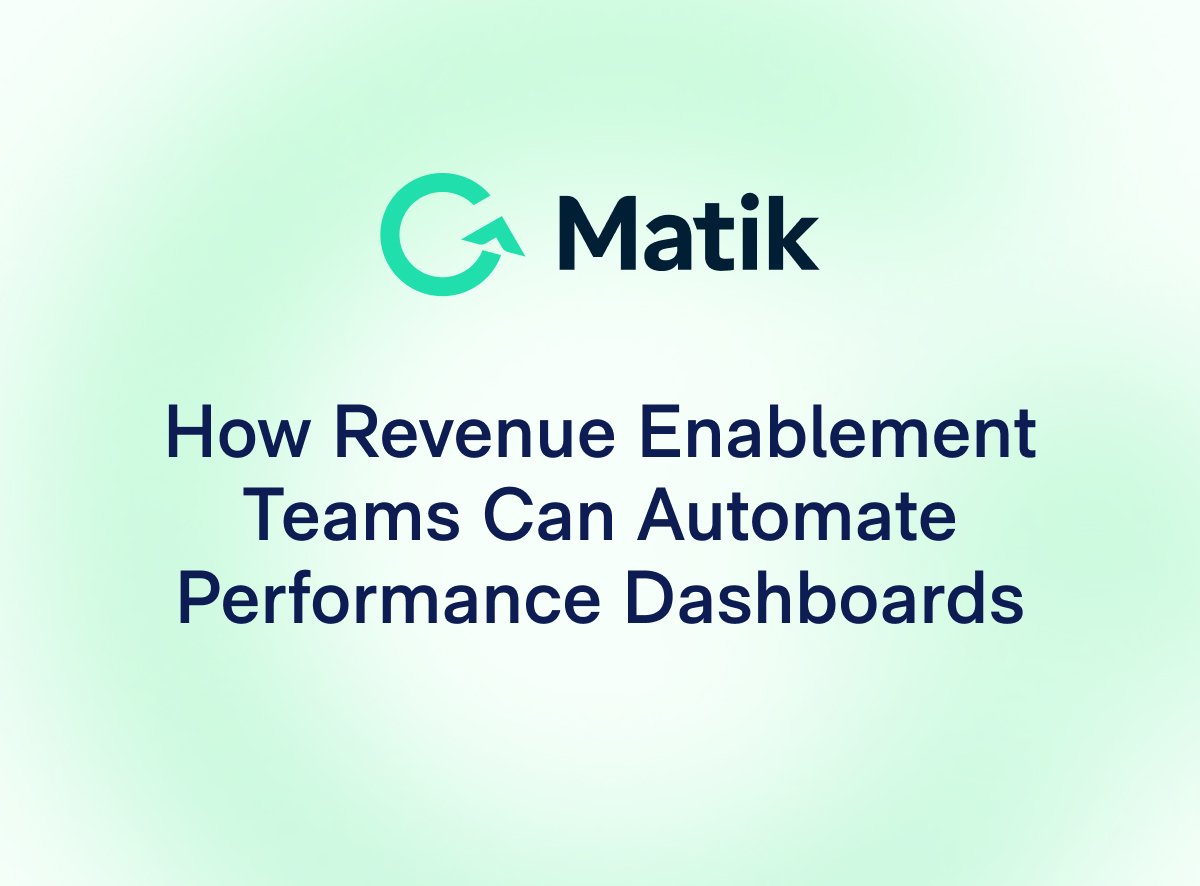Join Our Newsletter
For Revenue Enablement professionals, your core mission is ensuring the entire Go-to-Market (GTM) organization has the data and insights necessary to execute effectively. Yet, a large part of your week is consumed by the manual, repetitive process of compiling, updating, and distributing Performance Dashboards for different audiences: Sales, Marketing, Customer Success, and Leadership.
Pulling metrics, creating reports, and ensuring consistency across various stakeholders is not only tedious but takes up time that could be spent on critical strategic analysis and scaling best practices. It’s time to move beyond being a data assembler to becoming a central, strategic partner. This guide shows you how to automate your revenue performance dashboards, eliminating last-mile manual work and scaling your team's impact across the entire revenue organization.
What is a Revenue Performance Dashboard?
A Revenue Performance Dashboard is the recurring, standardized report (often a presentation or document) that communicates key metrics and insights to specific stakeholders, such as the weekly Sales Team dashboard, the monthly Executive Revenue report, or the quarterly Marketing Funnel review.
Typical Metrics:
- Pipeline creation and velocity
- Sales and Marketing conversion rates
- Team-level attainment and forecast accuracy
Why Automate a Revenue Performance Dashboard?
The data for these crucial reports often has to be manually stitched together from your CRM, BI tools, and data warehouse. For a Revenue Enablement leader, this manual process creates three major bottlenecks:
- Inconsistent Data: Revenue metrics, team performance KPIs, and conversion rates are often manually compiled from scattered CRMs, BI tools, and data warehouses. This leads to errors and misalignment when different teams rely on slightly different or outdated versions of the truth.
- Wasted Time: You spend hours every week compiling these dashboards, which is work that is repetitive and takes away from high-value, proactive strategy. Instead of diagnosing performance gaps or designing new training, you're just formatting charts.
- Lack of Personalization at Scale: While the executive team needs an ARR summary, a regional sales manager needs a localized team breakdown. Creating and maintaining unique, personalized dashboards for every audience is manually impossible, leading to a "one-size-fits-all" report that serves no one well.
Automating these reports transforms your process, enabling you to deliver accurate, consistent, stakeholder-ready narratives instantly.
How Revenue Enablement Teams can Automate Performance Dashboards
You can use custom scripts or workflow builders to automate some data pulls, but if you need a solution that instantly creates on-brand presentations and documents with accurate data and guardrails for consistency, then consider Matik.
Matik is an AI solution that automates the creation of presentations, documents, and reports directly from your data. This is how you can quickly and easily automate recurring Revenue Performance Dashboards for multiple audiences:
- Upload a Template: Upload your existing Performance Dashboard template into Matik. This is the file that you'll be automating.
- Connect Data: Connect the data sources you need, such as your CRM, BI tools, and data warehouses, directly to Matik.
- Map Content: Select the specific text, tables, charts, and other metrics you want to pull from your data source and map them onto placeholders in your template. This action tells Matik where to place the content every time you generate your dashboard.
- AI-Powered Content: Matik’s AI automatically queries the connected data sources each time the content is generated, ensuring real-time accuracy. Matik’s AI is designed with guardrails to instantly generate text, visuals, tables, and key insights based on the live data, leading to accurate and consistent content.
- Apply Variables for Personalization: You can further personalize the data and information shown in the performance dashboard by selecting variables. This ensures the dashboard is perfectly tailored for the recipient. Some examples include:
- Reporting Period: (e.g., Weekly, Monthly, Q3)
- Department/Team: (e.g., North America Sales, EMEA Marketing)
- Goal vs. Actual Metric: Used to highlight specific variance analysis for that audience.
- Generate and Distribute: Matik allows you to schedule the automatic generation and distribution of these dashboards, or a stakeholder can instantly refresh the data within an existing report right before a meeting.
The Strategic Advantage of Matik for Revenue Enablement
For Revenue Enablement, the most significant win isn't just saving time, it’s the ability to enforce a consistent, data-driven narrative across the entire GTM organization.
- Standardization & Alignment: Matik standardizes and automates your core reports, streamlining reviews and ensuring every team is looking at the same accurate data and using the same messaging. This enforces trust and alignment from Sales through to Finance.
- Agile Insights: By automating the mundane, Matik eliminates the delay between data update and report delivery. This empowers agile planning and trusted decision-making, ensuring leaders have the most current and accurate data for strategic adjustments instantly.
- Built for Content, Not Just Data: Unlike BI tools that focus on data visualization, Matik focuses on data storytelling. It turns your metrics into ready-to-present documents, reports, and decks, allowing you to scale the delivery of tailored, impactful insights without building custom dashboards for every single request.
---
Ready to turn your GTM data into clear, consistent, stakeholder-ready narratives? Request a Demo










